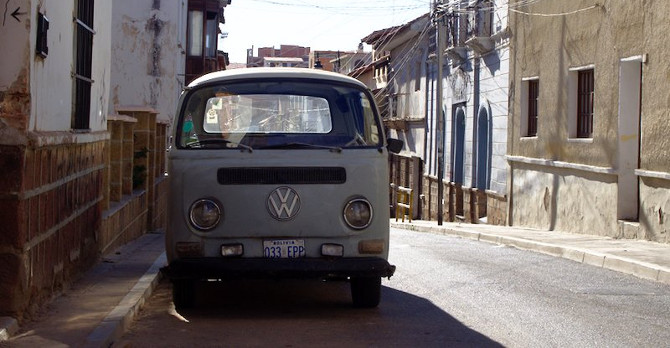May 29, 2016 0
Backpacking South America (Part 3)
To me, one of the most interesting things when travelling is to discover food. After having been to Thailand, I started to love Tamarind, Thai Tea, and Singha Beer. In Bolivia there have been a couple of similar things so far. The Cherimoya is a fruit which I have tasted occasionally in Germany, but it is very hard to find there. Here, in Bolivia, it is everywhere. And it tastes awesome! We also have a lot of fun buying random things in Supermarkets, which are not available in Germany but seem to be popular here — Fanta with Papaya taste for example (wuah…) or a wide range of sweeties which one cannot possibly have imagined (see photo below).
A while ago I started reading on the digital nomad scene — travelling around and making money working over the Internet, e.g. as a developer or designer. Within the scene one can find a lot of tips on how to live “on the road”. One repeating tip is a product called Sugru. From the product description: “…mouldable glue that turns into rubber. We invented it to make fixing and making easy and fun.”. Basically you get a couple of small packages in different colors. After you open a package you have time to form the glue. If you have created a desired form, you leave it to itself and after a couple of hours it hardens. If you just type “Sugru” into the image search of your favorite search engine you will find a lot of examples how it can be utilized. My favorite one is “How to make any toy LEGO compatible!“, though there are a lot more examples that have way more practical applications. I have a pack of Sugru with me and have been looking for an opportunity to try it out. Finally, I found one and recently used it to fix a shower in a cheap hostel. Basically the shower head needed to be held in the hand since the wall mount had been broken. Thus the shower head could no longer be attached to the wall. Sugru to the rescue!
On another note, I have started to occasionally contribute to Wikitravel in the last weeks. Adding some content here and there or fixing mistakes. In the last weeks I have utilized Wikitravel a lot and read many pages. After having actually been to the cities and checked out some of the stuff, some outdated information came up. I find contributing there to be actually quite rewarding. I would like to write a complete article about a village or city which does not exist there yet. It bothers me a bit that in the past I have been to a number of cities which don’t have an article, without having taken this opportunity. But maybe we will find an uncovered village in the next weeks.
I have finished another book in the meantime: Consider Phlebas by Ian M. Banks. This is the first book from his Culture Series. Hardcore Science-Fiction, artificial intelligence, interstellar wars, and space ships. I got interested in reading the books after having read that Elon Musk named various SpaceX facilities after things from the books (more details). I liked the book a lot, though I was a bit disappointed by the ending. But overall it is very well written and thrilling. It reminded me of the Ender Series, though the universe and the characters differ in a lot of ways. I am eager to read more of the Culture Series, from what I hear the first book is sometimes considered the weakest.
So, after an awesome stay in Sucre we went to Cochabamba. But we both didn’t feel comfortable in this city. Maybe this was due to two succeeding holiday days. There was very little going on here, many restaurants, markets, shops, etc. were closed. Very few tourists or backpackers. This seemed to bring out even more of the negative kind of people that plague tourists and backpackers. I haven’t yet gotten asked that unfriendly and penetrative to buy e.g. flowers. Neither have I yet been insulted when kindly declining. There were a couple of nasty experiences and interactions and we both were eager to leave Cochabamba. So currently we are heading to La Paz and I won’t switch on my laptop for a while, mechanical hard drives are mostly not laid-out to be operated on +3000m and data corruption can get a real problem (your warranty may even expire if you take your laptop above 3000m). SSDs are not affected. The issue seems to be caused when the thin air in high altitude is unable to further support the read/write heads of the hard drive. Thus they might scratch the delicate disk surface and damage them. So yes: Laptops can get altitude sickness as well.










